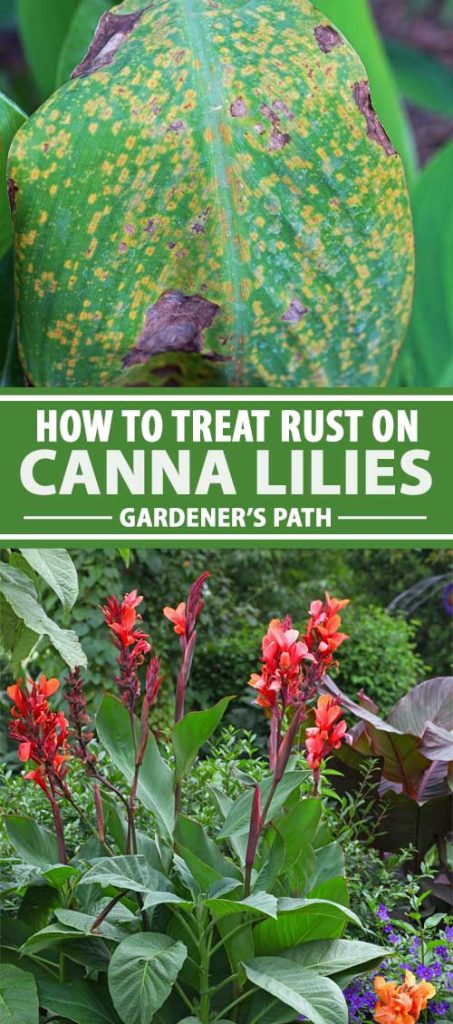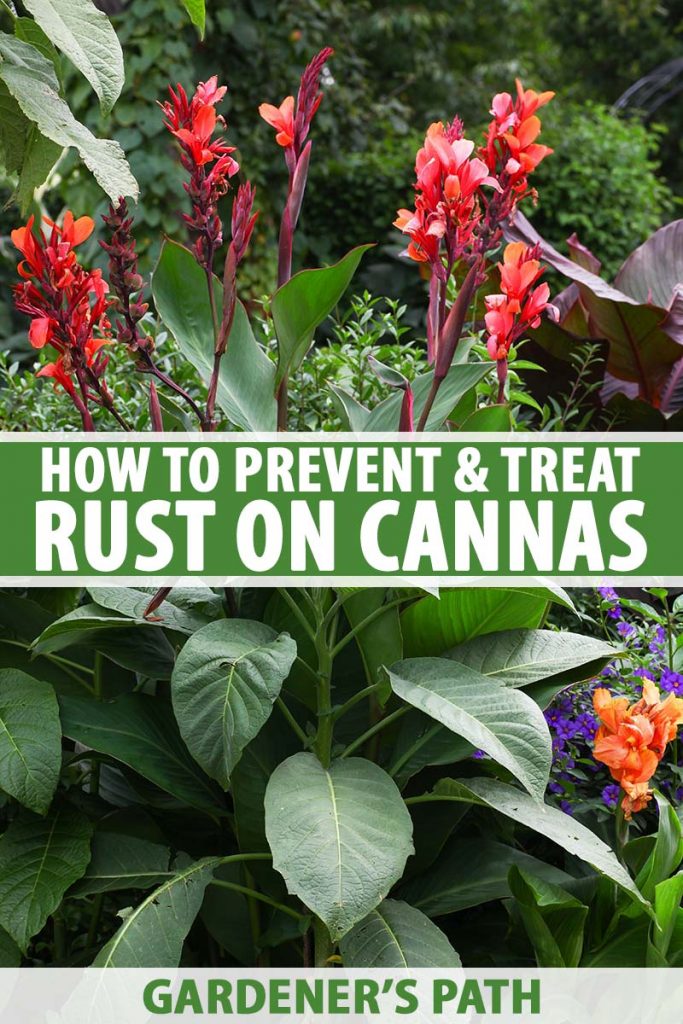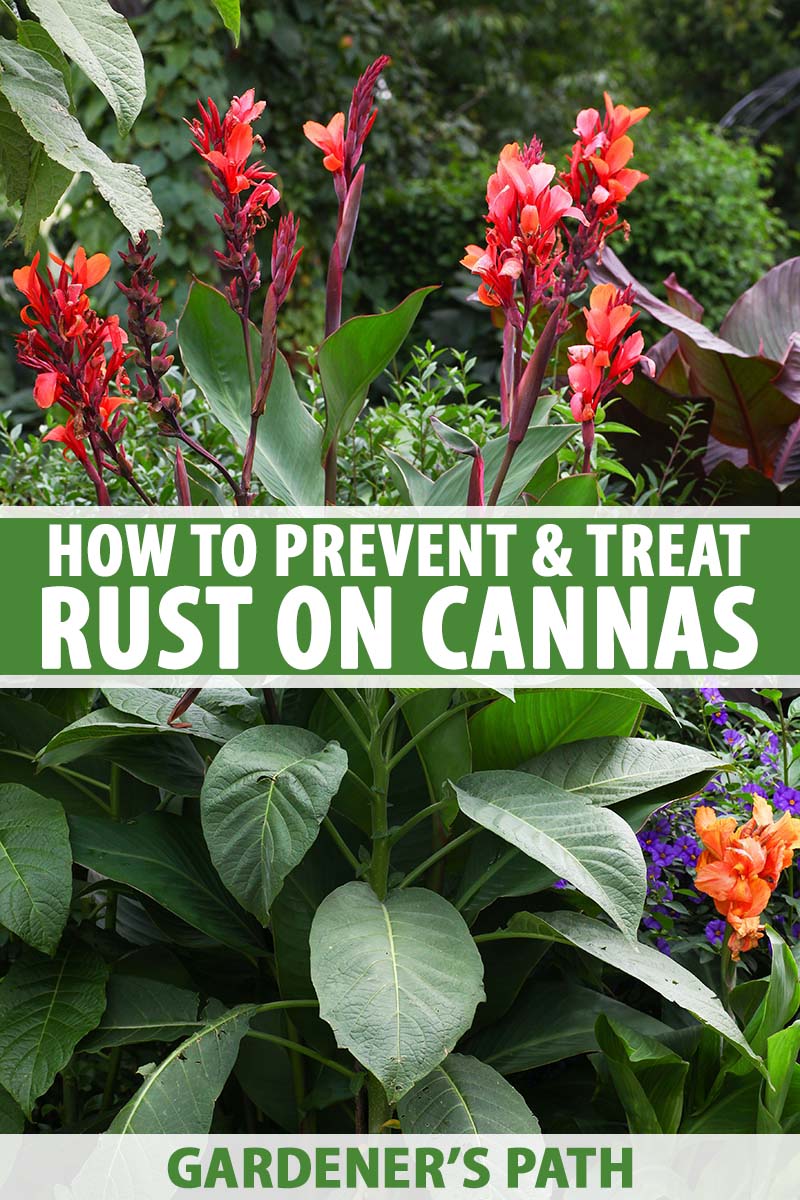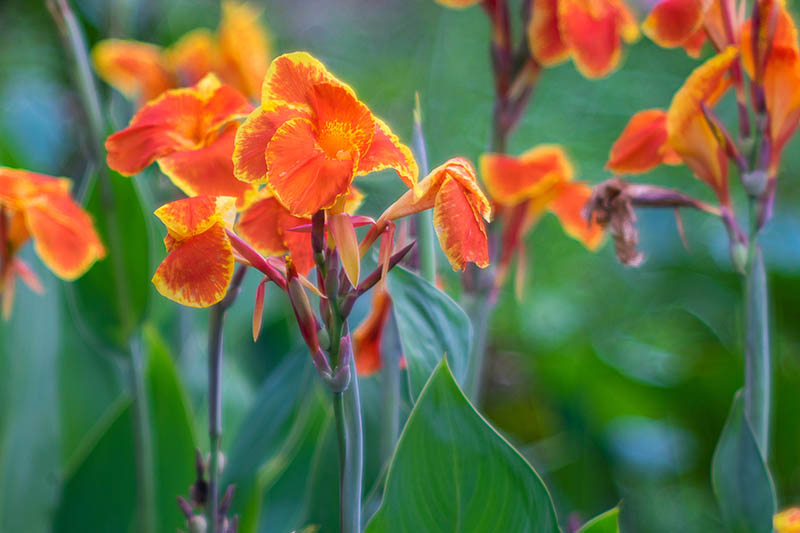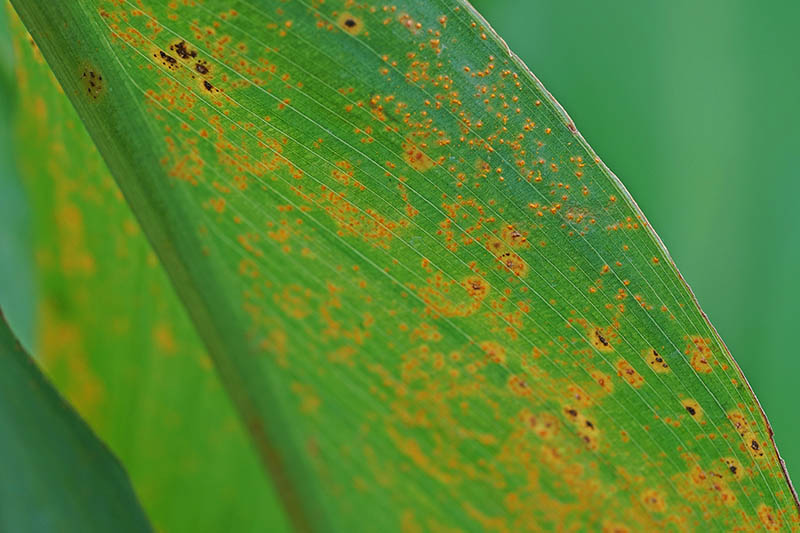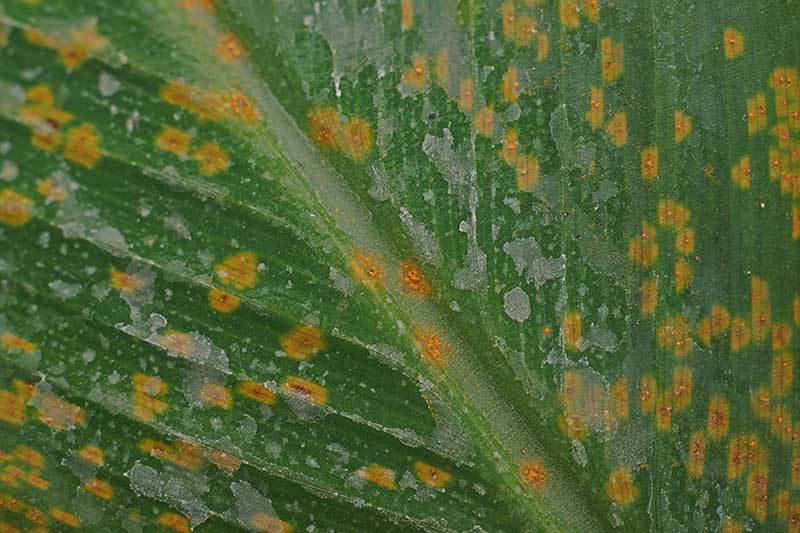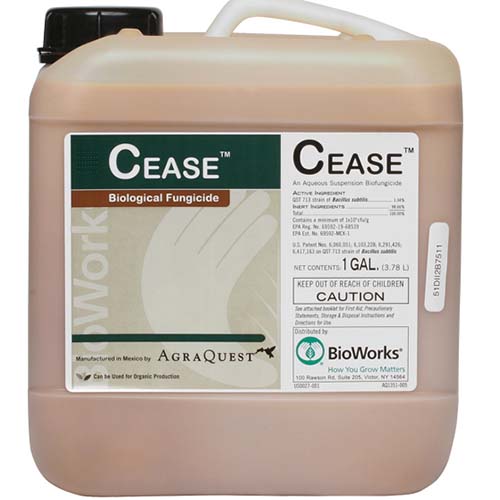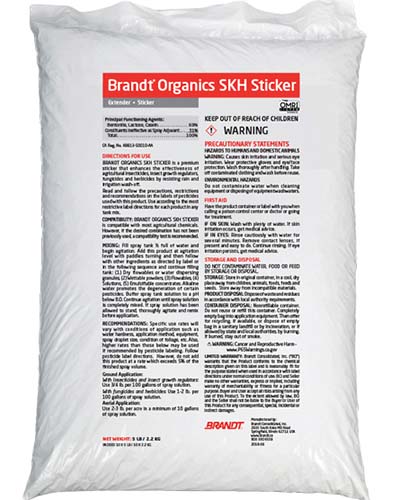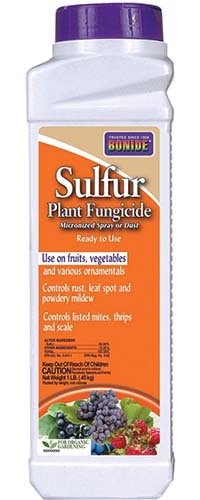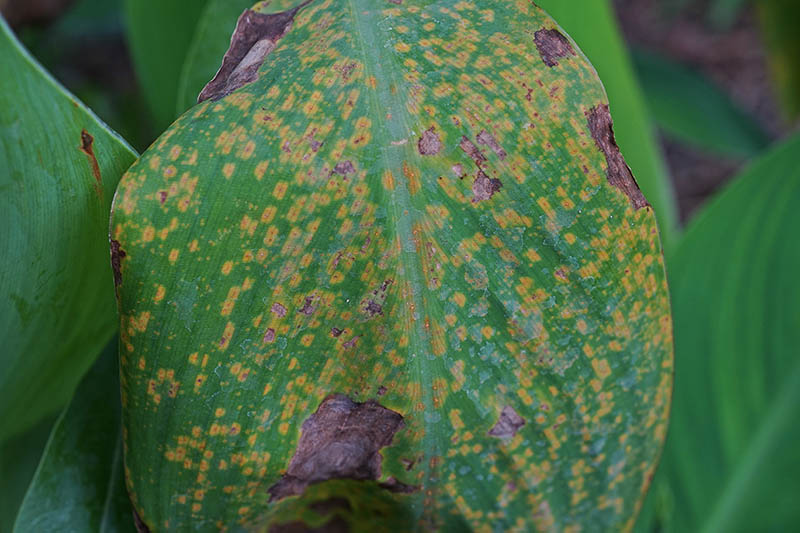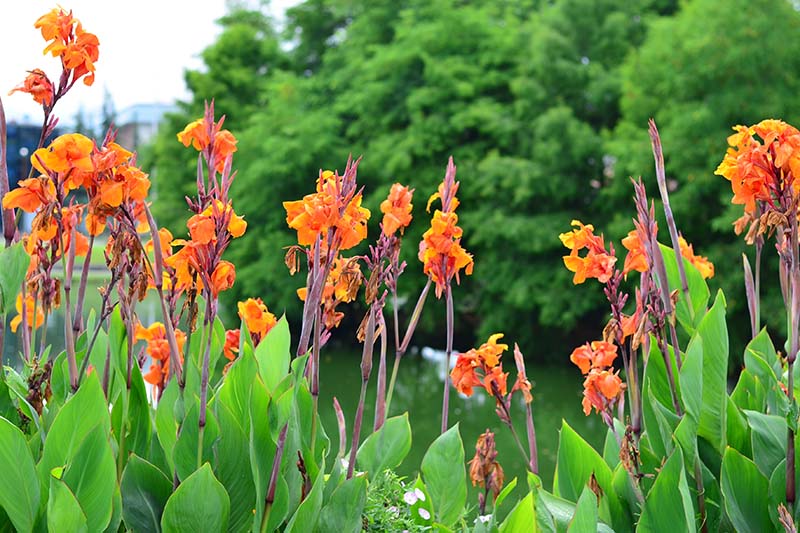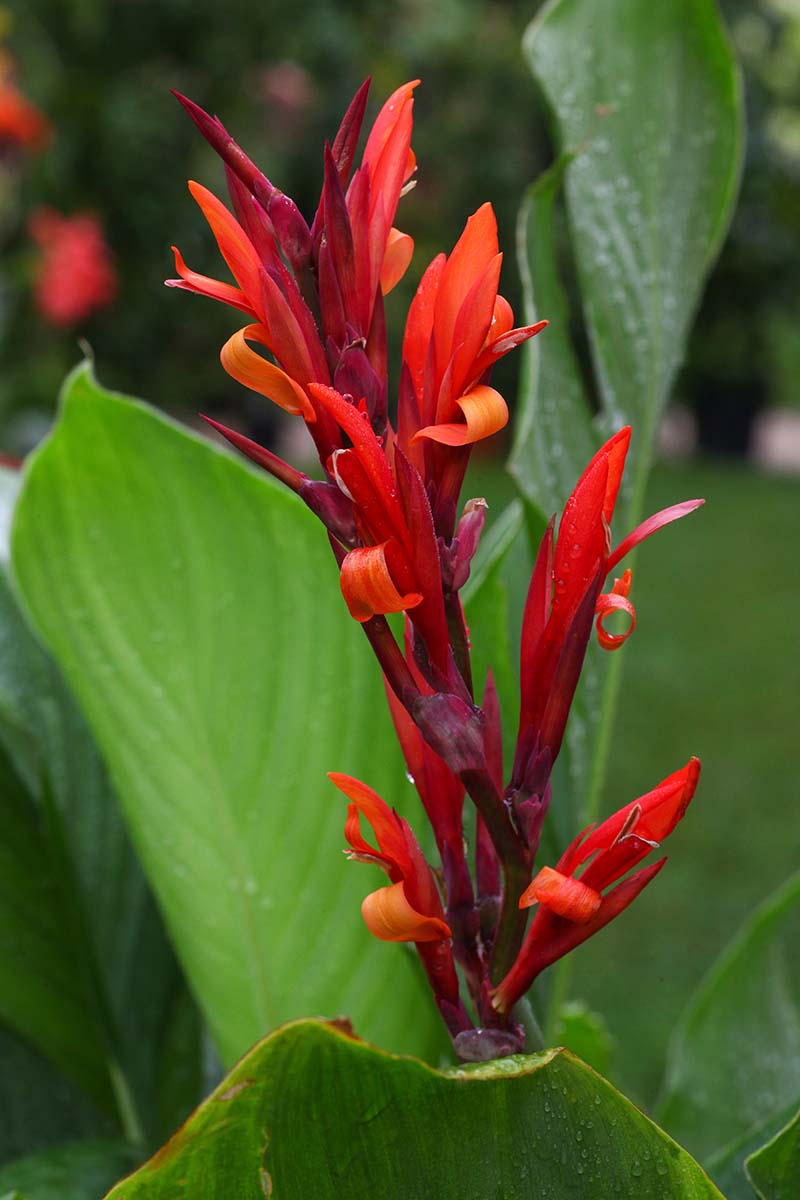Often called canna lilies, they are neither lilies nor lily relatives, but share the same monocot structure – petals in multiples of three are one characteristic of this form. And while they are often called bulb flowers, they are not actually true bulbs, but flattened, fleshy rhizomes. Suited to gardens in USDA Hardiness Zones 7 to 10, canna is an herbaceous tropical perennial native to South America. We link to vendors to help you find relevant products. If you buy from one of our links, we may earn a commission. Species have showy flowers in shades of red, orange, pink, white, and multicolor combinations. Mature heights range from a petite 18 inches to a towering eight feet tall. Leaves are broad and paddle-like, and may be solid or striped, and bright green, purple-green, or bronze in color.
Sometimes, canna falls victim to a fungal condition called rust. In this article, we discuss how to recognize, manage, and prevent canna rust. Let’s begin by defining the condition.
What Is Rust?
Rust is a type of plant disease spread by fungal spores through air, and sometimes by water. The fungus feeds on live plant tissue, and the disease gets its name from the powdery red-brown coating it leaves on your fingers when you brush them across an affected leaf. Different types of rust have different preferred host plants. A type likely to affect canna plants is borne by a fungal parasite called Puccinia thaliae, formerly known as P. cannae. It may cause systemic damage, affecting the leaves, stems, and flowers, particularly of some hybrid varieties sold as C. x generalis.
The Warning Signs
The first warning of a potential rust outbreak may be rain in the forecast.
An increase in the relative humidity of the air surrounding canna plants, combined with foliage that is wet for extended periods, creates a prime breeding ground for P. thaliae. Often the first sign that plants are oversaturated is leaf yellowing, or chlorosis. Here’s the part I find most interesting: The fungus begins its course of destruction stealthily, under the leaves, often going unnoticed until the infection is severe. On the undersides of the leaves, there are pores called stomata that allow for the passage of air and water in and out of the plant. It is through these openings that the infection enters plant tissue. The hungry microorganism begins to nourish itself with the leaf tissue, leaving a trail of telltale blister-like spots, or pustules, that may range in color from yellow to tan, along the veins and midribs. As the feast continues, the bumps merge into large rusty patches. At this point, the damage below the surface of the foliage is so great that it becomes evident above. The leaf surface may begin to show blotches of dead, or necrotic brown tissue that eventually breaks, leaving holes where there was once healthy plant tissue. In extreme infections, the damage may not be contained to the leaves, but may migrate to the stems and flowers, causing discoloration, deterioration, and wilting. Once rust presents itself, all nearby cannas are vulnerable to its spread, especially if the damp weather persists.
Treatment Options
The unfortunate truth about canna rust is that once it rears its ugly head, it’s hard to eradicate.
The first course of action is to remove affected plant material, or to remove entire plants, rhizomes and all, to contain its spread. Do not place the debris on the compost heap. Dispose of it in the trash, or burn it if you live in a community where incineration of yard waste is permitted, and then dispose of the residue. You may read that applications of copper-based fungicides can slow the spread of rust. However, in addition to their potential to impair canna’s nutrient uptake, the heavy metal is highly toxic and of questionable value in the home garden.
Rust is hard to treat because it can become fungicide-resistant. For this reason, different products are often used in alternating fashion. One is usually a contact treatment, and the other, a systemic one. However, this process can become quite involved, and is likely to try the patience of the home gardener. Read more about alternating fungicides in the home garden to prevent resistance. You may also have heard that neem oil is effective. While it is organic, and clings beautifully to leaves, it is not a very effective treatment for rust and may be wasted in its use.
CEASE™ from Arbico Organics This product is a contact treatment that offers two excellent features: First, it is a biological fungicide that contains Bacillus subtilis, a naturally occurring microorganism, specifically a bacterium, as opposed to a chemical. When sprayed on the plant, the bacterial spores compete with the fungi to disrupt their growth. Second, P. thaliae is unlikely to build up resistance to this product. Find CEASE™ now from Arbico Organics in various package sizes. See our guide to controlling plant pathogens with B. subtilis to learn more. However, CEASE™ is not rain-fast, and requires the application of a “spreader sticker.” Sticker products augment contact fungicides by enabling them to remain on plant surfaces despite rainfall. Arbico Organics offers a spreader sticker called Brandt® Organics SKH.
Brandt® Organics SKH Sticker This product is compatible with most agricultural chemicals, but compatibility testing is advised. Find Brandt® Organics SKH Sticker now from Arbico Organics in 5-pound packages. In addition to copper-based fungicides and alternative biofungicides, sulfur-based products offer another avenue of treatment. Arbico Organics offers a product called BONIDE® Sulfur Plant Fungicide. It’s another contact fungicide, like CEASE™, that is applied to the foliage and prevents fungal spores from germinating.
BONIDE® Sulfur Plant Fungicide However, unlike CEASE™, fungi may become resistant to BONIDE®. Find BONIDE® Sulfur Plant Fungicide now from Arbico Organics in a 1-pound bottle or a 4-pound bag. And finally, even if you treat plants, fungal spores are likely to overwinter on decaying plant material or on the ground, only to return with the first damp spell of the next growing season.
Proactive Measures
Since weather is not a controllable factor, and fungicide treatments may be risky, challenging, and unsuccessful, the best way to approach rust may be through prevention.
Here are 11 best gardening practices to prevent rust on your cannas:
Take a proactive stance toward keeping rust at bay by selecting rhizome varieties that have been bred for superior disease resistance.
Choose a location with at least six hours of direct sunlight per day to help moisture evaporate from foliage. Fungi love the shade.
Provide rich soil that drains well, so excess moisture isn’t pooling and raising the relative humidity at the soil level. To improve drainage, add sand, or compost that brings with it munching earthworms to help aerate the soil.
Apply a layer of mulch over the roots to aid in moisture retention during hot summer days.
Keep weeds away. They compete for water and nutrients, and can harbor fungal spores. Mulching also helps to inhibit weed growth.
Deliver an inch of water per week, but only if rainfall isn’t sufficient. You can monitor local precipitation with a rain gauge. When watering, aim your hose at the roots, not the leaves. Keep the foliage as dry as possible. Consider using a drip irrigation system. The slow trickle facilitates good drainage, while keeping water off the leaves.
Observe spacing recommendations of one to two feet to avoid overcrowding plants. Air needs to flow between and around plants to keep the humidity down.
Deadhead spent flower stems and prune leggy or excess foliage periodically to enhance airflow. Cut spent blossom stems to their points of origin to let air and light in, and to make way for fungicide penetration (if using). Unlike some plants, cannas do not rebloom after deadheading.
Sanitize garden tools with a 10 percent bleach solution to avoid introducing potentially harmful pathogens to plants and plant environments during tasks such as deadheading and pruning, digging, and weeding.
Canna is a heavy feeder. Give plants a jump-start with a dose of 5-10-5 (NPK) fertilizer at the beginning of the season, for a healthy flush of growth. Healthy plants are less vulnerable to disease. Read more about fertilizing canna lilies here.
And finally, if you’ve had a rust outbreak, rotate planting locations for next year, as the fungi may winter over. In addition to the best gardening practices listed above, you may apply fungicides as a preventative measure shortly after planting and during the growing season, per package instructions. As mentioned, P. thaliae is likely to become resistant to some treatments more than others, and alternating products may be the best course of action.
Grow Cannas with Confidence
Canna makes a bold vertical statement with a tropical flair that is as attractive in containers as it is in the garden.
Yes, opportunistic fungi are out there waiting for that rainy spell and those tantalizingly wet leaves. However, you can foil their attempts to colonize with best gardening practices and the scrupulous application of fungicides. And if you’re gardening in a region with frequent summer rain and high humidity, containers that you can roll under the canopy of a patio, until the clouds break and the sun returns, may be the way to go. Don’t let worries about rust undermine your enthusiasm! Add canna to your garden planner today. Are you growing canna lilies and have you had problems with rust? Let us know in the comments section below! If you are growing canna lilies you may also like to learn about growing these stunning flowers next:
How to Identify and Control Common Canna Lily Pests How to Grow and Care for Hardy Hibiscus How to Grow and Care for Passionflower
© Ask the Experts, LLC. ALL RIGHTS RESERVED. See our TOS for more details. Product photos via Arbico Organics. Uncredited photos: Shutterstock.
